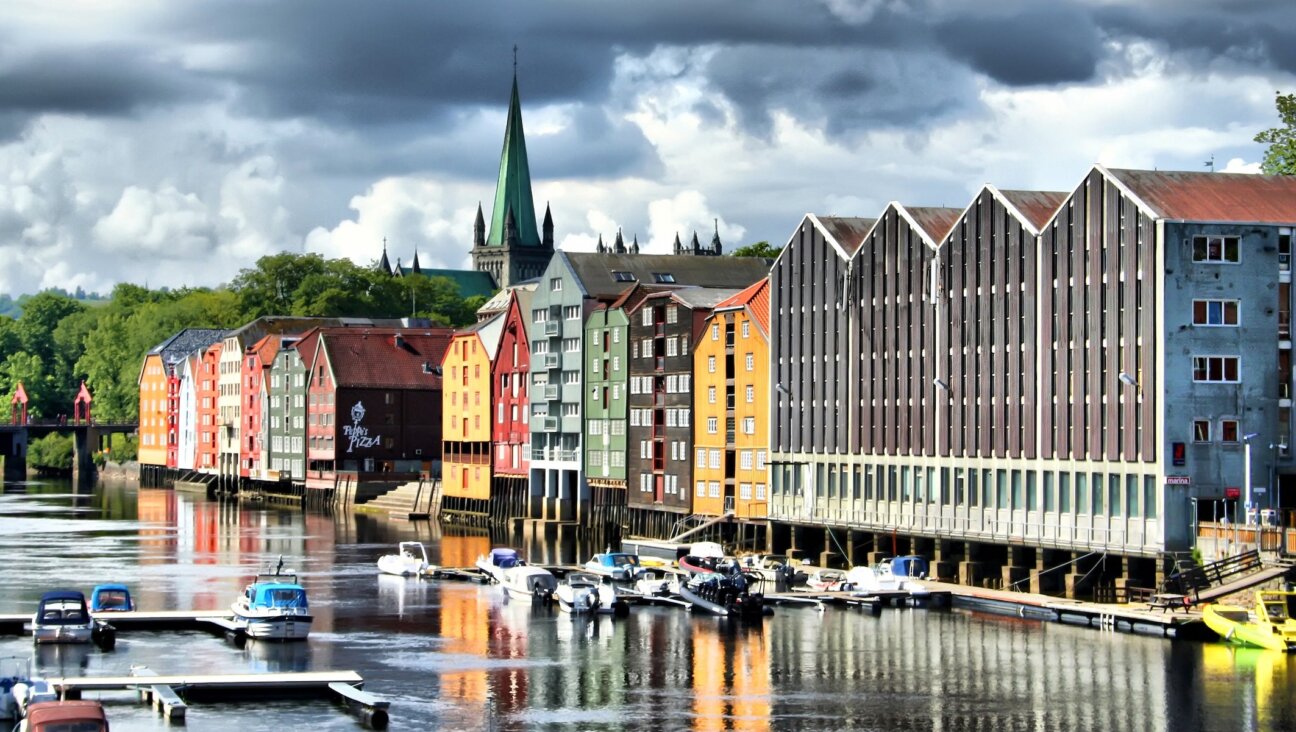Traversing the World, in Search of Jewish Stories
REEL LIFE: In a banner year for documentaries, yet another gem emerges –– ‘Dziga and His Brothers,’ by Yevgeni Tsymbal, center. Other films include, from left to right, ‘Hiding and Seeking: Faith and Tolerance After the Holocaust,’ ‘Alila’ and ‘Kafka Goes to the Movies.’
This year’s New York Jewish Film Festival features a variety of topics, attitudes and historical perspectives, with one film in particular — a documentary about Soviet filmmakers — stealing the show.
From Tel Aviv to Manhattan, from the wilds of Canada to the villages of Poland, this year’s films travel across the world in search of fascinating and little-known Jewish stories. If film festivals can be said to have themes, this year’s Jewish Film Festival — a collaboration between The Jewish Museum and The Film Festival of Lincoln Center — is about outsider-dom. Many of the films being screened focus on the condition of the stranger and attempt to explore the nature of a circumstance so familiar to the Jewish people throughout the course of history.
Marlaine Glicksman’s “The Commandment Keepers” documents the lives of a little-known Jewish group living in New York City: the members of the Ethiopian Hebrew Congregation in Harlem, who have survived for 75 years despite a less-than-warm embrace from local rabbinical authorities. Providing a similar “Last of the Mohicans” vibe is another documentary, Solomon Nagler’s “Untitled 2 (The Last Jew of Edenbridge),” about the last living member of a Jewish farming colony in rural Canada. Menachem Daum and Oren Rudavsky’s “Hiding and Seeking: Faith and Tolerance After the Holocaust” follows a trip taken by Daum and his teenage sons to Poland. Daum and Rudavsky, directors of “A Life Apart: Hasidism in America” (1997), attempt to portray the complexities of Jewish-gentile relationships in Eastern Europe, both during World War II and afterward.
Similarly, two acclaimed Israeli filmmakers offer portrayals of lives of individuals outside mainstream Israeli society. Ra’anan Alexandrowicz, director of the 2001 documentary “The Inner Tour,” tries his hand at fiction filmmaking with the satire “James’ Journey to Jerusalem,” about a Christian pastor from Africa who travels to the Holy Land and has a distinctly unholy experience. The film explores one of the least-documented aspects of contemporary Israeli life: the hundreds of thousands of foreign workers currently living and toiling in Israel. Amos Gitai, whose previous inquiries into the state of Israel’s soul include “Kadosh” and “Kippur,” returns with “Alila,” a story based on the novel by Yehoshua Kenaz about the inhabitants of a shabby Tel Aviv apartment building.
From the slightly oddball department comes Hanns Zischler’s “Kafka Goes to the Movies,” an exploration of the famed writer’s love for the medium of film, using excerpts from his journals and clips of some of his favorite movies. While more than slightly esoteric — what’s next, “Marcel Proust’s Preferred Bathroom Soaps?” — the film should be a treat for any lover of Kafka’s work.
But one film outshines the rest. This past year has been a banner one for documentaries. From “Spellbound” to “My Architect,” “Capturing the Friedmans” to “The Fog of War,” filmgoers have been treated to a year chock-full of superb documentaries on subjects familiar and mysterious. Yet another gem will have its New York premiere at the Jewish Film Festival: Yevgeni Tsymbal’s “Dziga and his Brothers,” which sheds new light on the world of early Soviet filmmakers.
From the perspective of 2004, the Soviet filmmakers of the 1920s and 1930s seem impossibly distant. With their gee-whiz enthusiasms for, among other things, the nascent revolution, the hum and throb of heavy machinery and the rise of the new worker, the idealism of major Soviet figures such as Sergei Eisenstein, Vsevolod Pudovkin and Alexander Dovzhenko feel like relics from some earlier, dramatically more innocent world. Tsymbal’s new documentary, showing January 20 and 22, takes another iconic figure of Soviet filmmaking, Dziga Vertov (along with his gifted brothers Mikhail and Boris), and rescues him in all his gritty specificity. Vertov emerges as a pungent mixture of high-minded Communism and dashed hopes, paying obeisance to a Soviet regime that ultimately denied him the privilege of the one task he lived for — making movies.
Vertov was born David Kaufman in Bialystok, a Polish-speaking city with a major Jewish presence. Leaving his roots behind, he adopted the name Dziga — Polish for “spinning top” — and began working on the cinema-trains, a new creation that simultaneously filmed the Soviet people at work and play, and showed them the results. Vertov was a born documentarian, but he professed little interest in the mechanical duplication of the world. His motto was “Shoot the world as it happens!” but Vertov saw himself as the world’s master of ceremonies, introducing the spectacle of daily life, from the pounding of machinery to the whir of his own cameras, from the miracle of childbirth to the mysteries of death. Vertov’s masterpiece, “The Man With a Movie Camera” (1929), is a film of the world in the largest sense, encompassing a multitude of perspectives and personalities. In true modernist fashion, the film’s canvas is so wide as to include the making of the film itself; in fact, one of its most stirring scenes involves the cutting and pasting of strips of film to create that unmistakable Vertovian montage.
Fundamental to the process of filmmaking was the input of Vertov’s cinematographer brother, Mikhail Kaufman. Willing to put his life on the line in the name of a better shot, Mikhail pulled off complex imagery (like a cameraman emerging from a worker’s beer stein) that today’s studio lensmen, with all the computer wizardry at their disposal, would have difficulty matching. Mikhail’s skill helped make Vertov’s early work a success, but he grew increasingly frustrated at his lack of control over the finished product, and at his brother’s messianic zeal for the Soviet Union. A lighter soul than his brother, Mikhail was more interested in cavorting with his latest girlfriend than promoting the latest Five-Year Plan. At the same time, the youngest Kaufman brother, Boris, moved to Paris, where he met a blazing wunderkind of the French cinema named Jean Vigo. Before Vigo’s untimely death in 1934, the pair collaborated on three magnificent films: “A Propos de Nice,” “Zero de Conduite” and “L’Atalante.”
The intensification of Stalin’s terror and the impending arrival of World War II brought much heartbreak to the Kaufman family. Mikhail was living with an Italian woman named Gabrielle, with whom he had a daughter. Living with, or even knowing, a foreigner, was an extremely dangerous state of affairs in the Soviet 1930s, and the NKVD eventually came around, collecting Gabrielle, who was never seen again, and murdering their daughter. Dziga’s films were increasingly criticized for their formalism, with two of his later works, “Three Songs of Lenin and Lullaby,” unceremoniously shelved by the authorities. Vertov’s star had dimmed so significantly that he was banished to the Kazakh city of Alma-Ata for the duration of World War II, denied permission to film. He spent the last 10 years of his life editing newsreel footage, a legend forgotten in his own lifetime. He responded to inquiries about his state of mind by saying, “Please don’t worry — Dziga Vertov is dead.” Boris was the most successful, although his life in later years was also fraught with difficulty. Fleeing France just ahead of the Nazis’ arrival, he spent 10 years in the United States struggling to make a living before getting his break, shooting Elia Kazan’s “On the Waterfront.” Boris won an Academy Award, but in a bitterly ironic turn of events, in order to get the job, he was required to deny his life in the Soviet Union, and his brothers, taking an oath that he had no relatives in Russia and knew no communists.
Tsymbal’s documentary cleverly appropriates the language and imagery of early Soviet montage to tell the story of the Kaufman brothers — a film about Vertov as directed by Vertov. The film, less than an hour in length, manages to quickly and expertly sketch the artistic and political realities of a wide swath of 20th-century life, from the Soviet Union under Stalin to Columbia Pictures under Harry Cohn. “Dziga and His Brothers” is a celebration of the tremendous energy and intellectual excitement of the first generation of Soviet filmmakers and a tragedy about their destruction by a Soviet regime more in love with the rifle than the movie camera.
Saul Austerlitz is a writer living in New York.






















